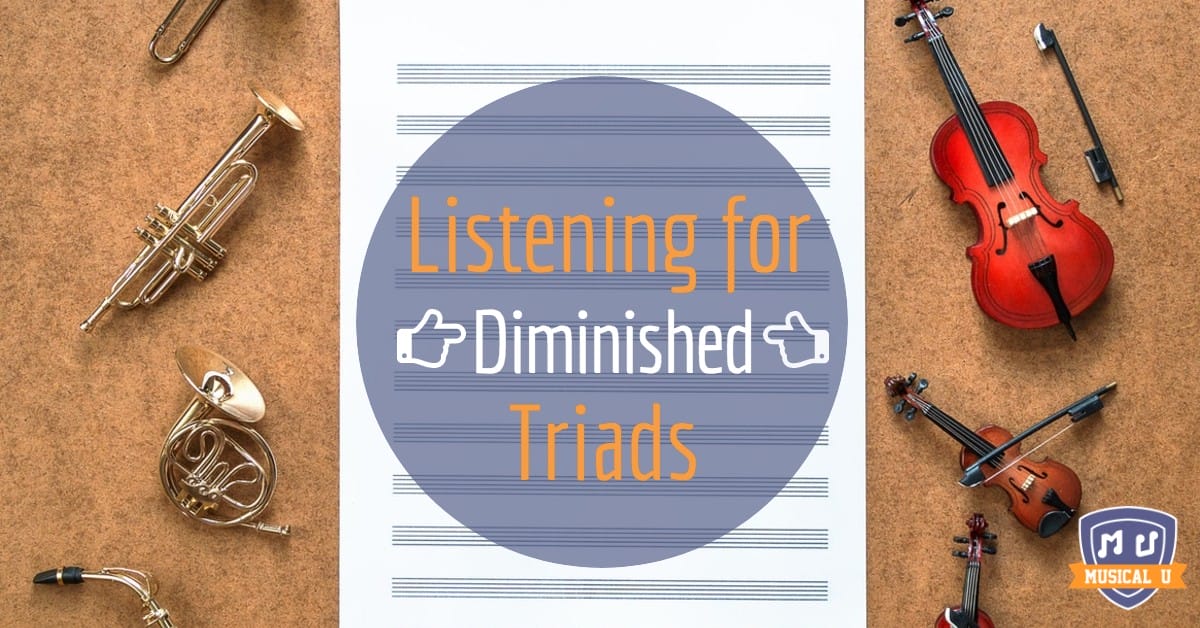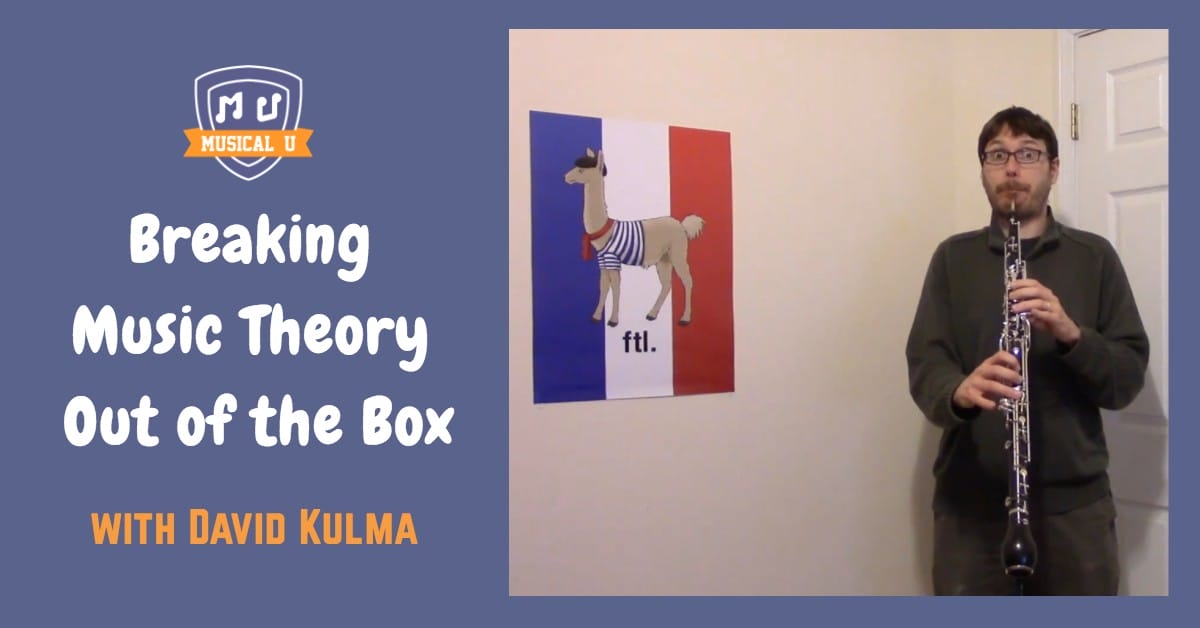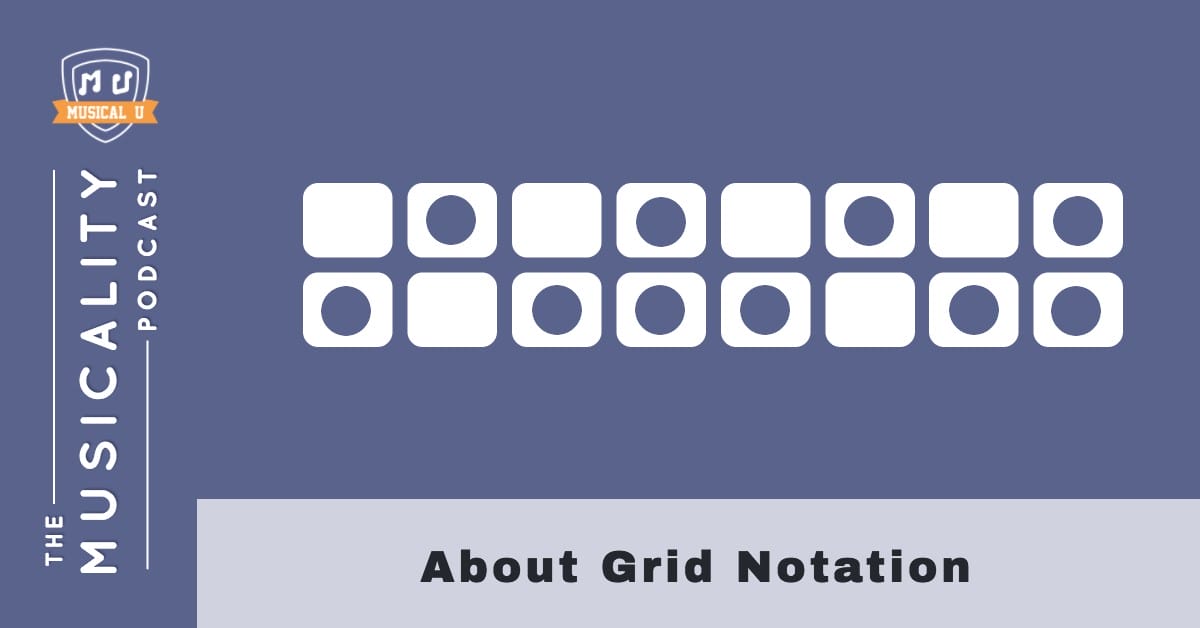Today we’re talking with Dave Carlton and Chris Anderson, two of the three creators of HookTheory – one of our favourite music-learning websites and one that can transform the way you understand melodies and harmony in the music you love. Ryan Miyakawa, the third team member, couldn’t be with us today but we’re hoping to have him on the show for a followup episode in future.
HookTheory is one of a handful of websites that we are constantly recommending to people who are learning music and looking for easier ways to understand music theory. We’ve been continually impressed with their approach and the quality of the teaching they provide, and it was a real delight to immerse ourselves in the two HookTheory books last year.
HookTheory is a new way of visualising notes and chords in music, as well as a very different and far more effective and interesting way of teaching core music theory concepts in songwriting.
In this conversation we talk about:
- The quite different musical backgrounds that the three HookTheory creators have and what they found a shared passion for that led to creating HookTheory together
- What makes HookTheory different and why that might matter to you
- Whether or not interactive tools like HookPad which make it easy to write music with computer assistance are removing the need for learning music theory yourself
If you’ve never been to HookTheory.com, we know this conversation will inspire you to go dive in, and if you’ve seen HookTheory in action, you’ll enjoy this peek behind the scenes of where such a cool project came from and what’s in store for the future.
Listen to the episode:
Links and Resources
Enjoying The Musicality Podcast? Please support the show by rating and reviewing it!
Rate and Review!
Transcript
Christopher: Welcome to the show, Dave and Chris. Thank you for joining us, today.
Dave: Hey, Christopher. Great to be here.
Chris: Yeah, it’s great. Thanks Christopher. It’s good to talk to you.
Christopher: So I’d love to begin at the beginning and understand, ’cause Hook Theory is a really interesting project in terms of the way you approach music theory and learning to write music. I’d love to understand where each of you is coming from in terms of music, how you got started and what music education looked like for each of you.
Chris: Sure, you — I’ll take the lead. So I’m a self-taught guitar player and I also play a little bit of piano and picked up guitar when I was about 21. It was my third year of college and I spent the summer at this internship. I moved in with one of my college buddies and he had this really sweet U.S., like, Fender strap and I just always thought — over in the corner or the room and he’d play it every now and then — and I’m, like, “Hey, could you show me a couple chords?” and so I started playing guitar and, you know, I would say I was a very typical, like, self-taught guitar player, I, you know, looked up tabs for, like, Wonder Wall and Led Zeppelin songs and just, kind of, like, continued to get better playing and learned more and more songs and, yeah, like, eventually I met Ryan, who’s one of the other Hook Theory people and this is like a couple of years after, so my first year of grad school and he ended up teaching me a little bit of music theory and so that ended up having like a huge influence on my musical endeavors, but, yeah, I definitely have no formal music education. In fact, I don’t — I mean, I can read sheet music, because, like, technically I know how to do it but I wouldn’t say I’m the type of person that looks at sheet music and plays it.
I think Dave comes from, like, a completely different —
Dave: Yeah. I certainly grew up, I guess I would call myself, classically trained. I grew up playing the piano from a pretty early age and then played the trumpet in high school band as well as college but I wouldn’t call myself a — I wasn’t a very serious musician. I certainly was, you know, practicing a lot but I wasn’t going into big important recitals or anything. So it wasn’t really until college and I took a lot of music classes in college and really got interested in it and that’s kind of when I think our shared interest for starting something like Hook Theory kind of began, when we got more serious about music.
Chris: Yeah, and then there’s Ryan, who’s not here, right now, but he — the guy, like, one of his memories as a kid is literally, like, sneaking down to — they had a piano at their house and he would, like, sneak down to the piano and play, like, little, like, not — I don’t know if it was pop songs, because he was, like, such a kid, but, like, little tunes he’d hear from, like, a cartoon or something that he would really like, but he wasn’t allowed to play those during his, like, music lessons so he would, like sneak down and play those and so he grew up with, like, a super-formal, you know, education from a very, very young age and, you know, he has, like, perfect pitch, is just an incredible songwriter, just, musically, just incredibly solid. I mean, you could put him in a room with pretty much any musician in the world and he could, like, he’d hold his own and so he, I think, like, is sort of the music glue that kind of brought the three of us together, I would say to even…
Dave: Yeah, when Ryan and I actually grew up…
Christopher: …get going on it.
Dave: …we were really, really good friends growing up. We went to the same elementary school, high school, college, grad school, so we go back a long ways and definitely would second everything that Chris said about his. He’s definitely a, I would consider a musical genius. (Laughs)
Christopher: Very cool. And so it sounds like you each have quite different musical backgrounds. Maybe Dave, you and Ryan have a bit more in common in terms of the classical training.
Dave: Yeah. I would consider myself very much in the middle. Yeah. And so I think, as you say, it’s kind of an interesting mix because it really covers a lot of bases from the casual guitarist to the really serious musician to kind of in-between.
Christopher: And how did that work for you guys? Because, you know, for my part, knowing musicians, they don’t always play well with others, particularly when you have that difference in backgrounds. Do you guys just find you clicked? Were there any awkward moments trying to find musical common ground, or…
Chris: Well, so I think, like we, I mean, we came together just as friends, right? So I met the two of them in grad school and they had already known each other for, like a long time, as David said, and I came into the group and we were just buddies for several years and — but it was really, I think, you know, when Ryan — so, there’s a part I kind of left out, which is when I first got to Berkeley, like, I, you know, I’d already been playing guitar for a couple of years and then as I started hanging out with Ryan I would sometimes, like, you know, have my guitar with me and there’s this, there’s this one moment that, just, I’ll never forget, which is one of the first times I came over to his house and I was sitting in the living room just strumming some chords on my Taylor guitar and he was in the other room, like, doing dishes, like not even looking at me and I had strummed a couple chords and I just hear him, like, kind of turn off the sink and he says, “Play a B minor,” and I am , I just, I’m, like, “What?” So I played a B minor and it was literally just, like, the exact perfect next chord and I’m like, “How did he know that?” Like, not only did he know, like, what chords I was already playing so he was able to hear that but then he knew what would sound good next.
So that was kind of the beginning of, like, I’m like, “How did you know that?” So he started teaching me essentially the basics of music theory and how music works but he did it in just the most awesome, intuitive, simple way, like, there was no sheet music. He just, like, explained things in a very fundamental, simple way and after about a year of that I was like, I always — in the back of my mind — was thinking, like, “God, I bet you every other musician in the world would love to have someone like Ryan teach them.” And that, in my mind, was, like, the seed of, kind of, like, of Hook Theory, actually. That was even, like, years before we ever even started building Hook Theory, but it was this way that Ryan taught me. And so we always knew that there was this kind of unmet demand of all these self-taught, you know, musicians that, you know, either carried sheet music or don’t have formal training and music theory is super intimidating to them and that would love this information but they needed, like, a consumable, like, you know, delightful, kind of, like, intuitive way to learn it and so it was easy, to answer your question. Like, we just came together and there was no question about, kind of, what we wanted to do and where we felt that the gap was.
Christopher: Cool, and one thing I’m always keen to ask about when I talk to people like yourselves who started these phenomenal projects, what gave you the drive to create something? You’d had this insight that there was a better way to learn music theory and you’d enjoyed the benefit of it yourself, but I know firsthand how hard it is to create something from nothing and get it out there and get it in a form that people like and enjoy and can use, so what was it that brought the three of you together to actually make that happen?
Dave: Good question. I think all three of us really like teaching and we also like building stuff together as friends so kind of combining those two together it kind of made it easy and it was just a fun thing for us to do so we just enjoyed working on it and obviously if it wasn’t something that we enjoyed doing we wouldn’t be doing it for the fun that we have.
Chris: Yeah, I mean, when we first started, we would just, it was, like, every week we would meet at Ryan — Ryan and David lived together at the time and we would — I would just go over to their house at, like, eight o’clock at night and we would just sit up in Ryan’s room until, like, 2:30 in the morning and just start, like, writing software and developing, like, our teaching method and the visualizations and all that stuff and it was, like, one of the funnest times that, I mean, it was cool, I just like building things, so, I don’t know, it was like, right after, kind of, like, that Facebook movie came out and, you know, it was like, just, you could just see, like, how awesome it can be to like, build something. Not that we’re anything close to Facebook, but yeah. It was fun. It was great.
Christopher: And so are the three of you all software developers by background? Do you all have that skill set to build something in terms of web software?
Chris: Yeah. Yeah, we’re all engineers by day, so that’s a kind of a shared skill that we all have, so it’s definitely been very useful to apply that knowledge to music and write software to help people learn.
Christopher: And Dave, you mentioned something before about how you’re — you consider yourself a classical musician and I think it might surprise some people that from that background you’ve created as part of a team a product that is so clearly oriented towards the creative side of music making, because, you know, the classical way of learning music is really about reproducing other people’s repertoire on your instrument to a large extent or very rigid, structured composition. I’d love to hear, what was it that led you to that approach to music or that outlook on what music making can be?
Dave: Yeah, I mean, for me, growing up as a classically trained musician, quote-endquote, it was always still very mysterious because I knew all my scales and I could play on the instruments but as you say, it’s very much just reproducing songs that other people have written and I really had no idea, frankly, how to go from a scale to a full song and that was something that Ryan obviously knew how to do and once I got to college and learned some more music theory I had to kind of pick some more stuff up, but it was always kind of a mystery and it was always something that I was very interested in and didn’t feel like there were any good resources available despite the interest that I had, even as a classically trained musician I felt like I was kind of lacking in resources.
Chris: Yeah, and I’ll just add to that which is like, you know, as someone who, you know, couldn’t read sheet music, you know, I was in grad school for, you know, like, engineering and you know, I’m fine learning new things but it was just, like, it felt like just such a huge barrier. I’m like, “Ugh, God, I got to learn how to read sheet music before I can even get started understanding any of these concepts.” It was like, “No, I’m not gonna bother with that,” you know? And so, yeah, seeing there was a path to the information that just, like, literally leapfrogged over the notation was awesome and we’re like, we got to share this with everybody.
Christopher: Yeah, and this may or may not be the same question as what makes a theory different and innovative, but you mentioned that Ryan had a particular way of explaining things that just made it so much easier and you wanted to share that way of teaching music with a larger audience. What was it that characterized that? What made it so different and so effective for you?
Chris: Well so the first thing — and this may sound just so incredibly simple, but it was the idea of songs kind of being in a key and that you can name the chords by the number chord they are in the key. So let’s go with, like, a simple example of chords that probably most people have played before, like if you play a G chord and then a D chord and then a C chord, those are all in the key of G and the G chord would be called, like, the first chord, because it’s the G chord and you’re in the G scale and then the D chord would be called the five chord and the C chord would be called the four chord, and that was, like, really the beginning of what Ryan was teaching me. He was like, “So when you play those chords,” he was like, “try in your head to just think of them as 1-5-4, you know? Don’t think of them necessarily as G-D-C.” And then he’s like, “So you can take that same pattern, 1-5-4, and, you know, play it in a different key, for example. So, you know, if you were going to start out in the key of D, that same pattern 1-5-4 would be, like, the D chord, the A chord, and then the G chord.” And so, I was like, “Oh, wow. So you can actually take, you sort of, you take the chord names,” which, there are so many chord names, right, because there’s basically, like, 12 different, you know, major keys. There’s all these different chord names and sharps and flats and blah-blah-blah-blah, and I’m like, “You could just boil it down to these seven numbers,” and that, to me, was, just, like, a really beautiful a-ha moment.
So I started thinking of songs and I’d be like, “Oh, you know, I want to play this, you know, Guns N’ Roses song,” and he’d be like, “Oh, that’s just a 1-4-6, you know, progression,” and I was like, “It doesn’t even matter what the key I play it in. I can just play that in whatever key I want and it’ll still fundamentally sound the same.” So that, like, basic concept was the thing that just, I was like, “This is so simple. How come this isn’t just common knowledge everywhere?” and, yes. It was really —
Dave: That —
Chris: Yeah, and I think beyond…
Dave: That simple.
Chris: …beyond that, then the fact that there’s tendencies that certain chords within that seven-chord system go together in different ways and, you know, if you’re playing a dischord, there’s another that’ll by likely be, will sound good if you play it next. It’s also kind of the next step beyond that and I always found that those were some of the tendencies that I didn’t really know and found really fascinating…
Dave: Yeah.
Chris: …as I was kind of learning my music theory and harmony.
Christopher: Hm. I’ve said this on the podcast a few times at this point but I am still kind of confused as to why this isn’t a bigger part of music education and for me growing up in the U.K. instrument learning system, you know, when you studied music theory you got a bit into functional harmony and you would have the basic intellectual understanding that, yes, you can number the chords and the key and you probably did some exercises to figure out what they’d be in different keys, but nobody made that bridge to the songs I was actually playing and what this might mean for playing by ear or how this might apply to figuring out melodies or improvising melodies and one of the things I love about Hook Theory is that you so naturally bridge those two worlds, you know, you’re rooted in functional harmony and how things have always worked but you’re talking very much in practical terms and using song examples that make sense to people and, yeah, I just think I still find it kind of flabbergasting that this isn’t normal. It sounds like you guys were feeling a bit the same, like, why isn’t it taught this way?
Dave: Yeah. To me it’s always – I mean, scales are very important, and you know, doing these intellectual exercises are super crucial, but it’s kind of, that was what music theory meant to me and so it didn’t have the connection to real music and that’s kind of one of the things that we tried to make.
Christopher: Hm. So that’s clearly one of the really defining things about Hook Theory, that you’re looking at everything in these functional terms. You’re talking about notes and chords relative to the tonic and so relative to the key. One of the other things that I think jumps out to someone who comes to Hook Theory for the first time is that it’s very colorful, which isn’t something we normally associate with music. You know, if you look at traditional staff notation, it’s black and white, that’s that. Tell us a bit about that color system and why it is such a colorful way of representing music.
Dave: Yeah, so we color every, all the scales degrees, these numbers of the scale and we give them the colors of the rainbow and then the reason we do that is to emphasize that regardless of what key you’re in, whether you’re in the key of C or the key of G, that one chord or that first note of the scale is always gonna be red and keep you grounded in that, in this functional system and it also, I think that one of the other reasons we do it is to reinforce the functionality of each of these notes in the scale by giving another sense, color in this case, to the scale degree and so it reinforces it and it’s kind of another ear training device to kind of help with that.
Chris: Yeah, and I would just add to that, this was right around the time when Guitar Hero, which is that game that was on PlayStation had just exploded and it just got so much traction and, you know, the simple beauty of that game was you had this control over four square buttons that were four different colors and you had basically four different, like, colors on the video game screen and you would just match color to color and we just knew that that was, like, an interface that people find intuitive and that colors, just, humans like color, and so it’s a nice tool that could quickly trigger a memory and, like, help you recognize patterns. So it’s like, you can just look at a song in Hook Theory and be like, “Oh, that’s red, red, blue, green, purple,” and maybe that’s to you what, you know, a 1-1 — I guess that’s 1-1-5-4-6 or I don’t even know what colors I said, but maybe to you, like, red, red, green, blue, purple is the sound, right, and that’s cool.
And originally, Ry- so Ryan — this is just a side note, ’cause this is kind of a funny story — so Ryan has synesthesia, which is this really, really interesting condition for those of you who don’t know about it, where he literally associates everything with a color, like, I mean, that, everything. So something like a musical pitch is like a very specific color to him, like I am a color to him, like, Chris is a color to him, like, Dave is a color to him, everything’s color. So he already had all of these colors for, like, scale degrees and they were these random colors and he would, like, really, really, really wanted them to be his colors, so it’s, like, “No man, we have to do the rainbow. Like, we’re not betting on this.” I think he’s finally okay with our color system.
Christopher: That’s great. I think it’s a really elegant solution that, you know, it makes me think of the Kodaly approach to solfa where you don’t just have a name for each note, you have a hand sign, too that gives that physical sense of, you know, what do is and how re relates to it and so on and I think it’s so powerful for giving the brain another handle on what’s going on in the music you hear.
So when we spoke back in two thousand, I think, thirteen, you guys had been up and running for a little while but it was still fairly early days and one of the things that was jumping out then was that Hook Theory was getting used a lot by songwriters to understand, you know, what are normal chord progressions and what are normal chord progressions and what are the options in terms of chords and songs. Was that what led on to the Hook Theory books or was that something that was always part of the vision for what Hook Theory could be?
Chris: I’d say the books were really kind of from the beginning. We really had this method in mind for what we wanted. We had something to say about how we wanted to teach music and we were gonna write those books and so that was really part of it from the beginning, yeah.
Dave: Yeah, so, I mean, the second book just came out about a year ago, actually, and that’s like the intermediate, advanced level stuff but we really, like, Hook Theory literally started with the first book, I mean, that was almost, you know, all of Hook Theory in the beginning and then as we built the, like, music examples for the book — so the book’s filled with all of these music concepts and every time we teach concepts we’ll show how it’s done in a real song so, you know, we analyzed probably, you know, a few hundred little clips of, like, Bob Dylan songs and Aerosmith songs and this and that in the first book and then we were like, “Well, these things kind of stand alone,” and then we had this idea. What if we could make a whole part of the website where you could actually see, like, the theory behind, you know, real songs that you like? Instead of looking up a guitar tab, you could look up, like, the functional chord changes and melody changes. And that was, when we launched, it was essentially the first book and then as the part of the website where at the time — they’re now called, “theory tabs” but at the time, I don’t even know what we called them. We called them analyses, I think.
Chris: Yeah, something less cool.
Dave: Yeah, but that was really, that was where we started.
Christopher: Awesome. I wrote reviews of the two Hook Theory books last year on our website and I think I said in one of the reviews, this is very much the music theory book I wish I’d had and I think there were two amazing things that do set it apart from your traditional music theory book and the first is just, the overall approach, the fact that you are explaining things, not, you know, “Here are the rules. This is how it’s always worked to learn the rules and apply them,” but “Let’s look at songs. What do songs do? Why do the chords do this in songs? How can we learn from that?” You know, it’s very much that practical and modern perspective on why music theory matters and the other amazing thing is that, you know, it’s hard to really convey in an audio form like this. I’ll put links to the reviews in the show notes so people can read and see screen shots and videos there, but, you know, these are books in the very modern sense of the word. This is something you use on your computer or your tablet. It’s got embedded videos, it’s got sound examples and you guys pack it with very clear, vivid illustrations, animations really, of what’s going on in the song as you hear it and I just, I’m jealous, in a way of today’s musician that gets to come up and use that as their theory book because I think it totally transforms your relationship to what theory can be and what it can do for you.
Dave: Well, thank you, I mean, that’s exactly why we created them, I mean, yeah.
Chris: Yeah, you couldn’t have said it better. (Laughs) Yes. That’s — yes. That’s why they exist. I mean, yeah, we felt the same way.
Christopher: And the last piece of the puzzle as it were I suppose is the Hookpad system which gives people an interactive environment for putting all of this into practice and starting to experiment. Can you tell us a bit about how Hookpad works?
Dave: Yeah, it uses the same system with the colors and, kind of thinking about music functionally as the system we teach in the book but it’s a very quick way of writing out your chord progressions and melodies in this system and so a lot of composers, songwriters will very quickly fire up Hookpad and then if you want to write a quick progression, 1-4-5, 1-5-6-4, you just type 1-5-6-4 on the keyboard and boom, you have your chord progression and it’ll play back for you and you can transpose it to whatever key. The key is sort of, like I said, it doesn’t really matter, but you can transpose it to whatever key you want and export it to your guitar tab or your conventional sheet music or if you want to compose something in Garage Band or Logic, you can export it as a midi. So yeah, we found it a very useful tool and for making connections to the books that you’re using as a companion while you’re trying to learn, it’s great for that, but if you want to try to write your own music it’s great for that, too.
Chris: Yeah, so and then Hookpad does some things that I still to this day just think are literally, like, magical, so one of the things that it does that I think is so cool is, say you put in a chord progression like Dave said, so 1-5-4. For those of you that are new to these numbers, let’s pretend we’re in the key of G. So I put down a G chord, a D chord, and a C chord. Very pleasant, nice sounding chord progression.
What Hookpad can do, so Hookpad has a chord staff and then above it it’s got a melody staff and Hookpad can tell you over each chord, so there’s three different chords there, G, D, C. Over each chord there’s kind of a subset of notes that if you base your melody around those notes your melody will kind of have this nice, stable sound and it gives you essentially, like, these guidelines for how to kind of lay out your melody. It’s not like, “Oh, use only these notes,” but it’s just saying, like, “Hey, you know, if you kind of make sure to include these notes at least by half the time your melody’s gonna sound pretty darn good,” and that is just the coolest thing ever, in my opinion and it’s one of the things that actually Hook Theory as a whole does, is it shows you these relationships between not, like, the chords on their own, but then also, like, how the melody relates to the chords and so Hookpad’s great for that.
Another cool thing about Hookpad is it can help you find out a good next chord so, like, and it’s called, “Magic Chord,” and you just — you can literally, if you want, just open Hookpad and just hit Magic Chord, Magic Chord, Magic Chord, Magic Chord and it’ll basically write, like, a little song and that’s really cool and when you do a magic chord it’ll tell you the context. It’ll say, like, “Oh, in 1972,” you know, “the Beatles used this chord in this same way,” and yeah, so it does some things that to me, like, now, that are just so normal, because I’ve been using Hookpad for so long but, wow, like, the ability to actually get a lot of help writing, composing a melody is something that the Hookpad does that really, I don’t think anything else can do that today. There’s nothing else. So yeah. That’s cool.
And we’re about to release Hookpad 2, which is going to have even more awesome stuff.
Christopher: That was a brutal teaser. (Laughs) Do you have a release date in mind? Can we tell the audience when to expect Hookpad 2?
Chris: Yeah, so I think we, we were, we started a year ago. It’s been, you know, a ton of work. We were hoping to do it to get it out before — in this year. Like, I don’t think we’re gonna hit that, but we’re really close so I would say —
Dave: Early next year.
Chris: Early, early — yeah. Early 2018. Yeah. It’s very, it’s getting very close.
Dave: Yeah. We’re real excited about it.
Christopher: Fantastic. So the two things you touched on there, I think, are great examples of what make your approach so innovative and interesting, you know, chord tones, for example. We had a recent podcast episode talking about how training your ear to hear the notes in chords can let you write melodies or play melodies by ear or improvise because you understand that connection between the melody and the chords and similarly, your Magic Chord feature does sound like magic and at the same time it’s something that, you know, songwriters traditionally have had to learn and internalize and kind of build up their vocabulary of what chords work well together.
Those are both things where, you know, traditionally technology couldn’t really help you and there’s a set of people these days who would argue that technology is removing the need to develop those skills. You know, if you have a tool like Hookpad do you really need to understand what a 1-4-5 is if you can just press the button? Do you really need to know how to listen for the notes in music if you can just kind of try things out and hear them played for you? Where do you guys stand on that? Do you see technology replacing the need to that kind of traditional music education?
Dave: Well, Hookpad really certainly makes experimenting easier with different sounds so in that way I guess it would help if you didn’t know anything but it’s certainly the more music theory you bring to the table, the richer your usability of Hookpad is gonna be, because it’s based on music theory and it talks the language of music theory so we certainly are firmly in the camp that the more you know the better your songwriting is gonna be and, you know, to use analogy, it would be pretty ridiculous if you wanted to be a poet but you didn’t think that you needed to learn the language and you could just get around, you know, putting words together randomly that you find in a word generator or something like that.
Chris: Right, yeah. I mean, music is always gonna be art in addition to any sort of scientific approach that one might take, you know, to writing a song and, yeah, like, this is, like, an even broader question, right, we’re getting into this future now where, like, all these, like, artificial intelligence and, like, virtual, kind of, intelligence things can help us do tasks in general, like, possibly better and I think ultimately, like, with music, though, it’s — there’s a — yeah. I think, like, in general that it’s — you don’t ever want to be so reliant on technology that that’s all, the only way you can do something, you know, I think, like, there’s always gonna be a moment when you’ll be, like, sitting around a campfire or something and you need to rely on your own skills and you don’t have Hookpad with you so, yeah, I mean, we definitely view it as a tool to help you explore, to help you create, and it’s kind of like if you were in a room with one of your good friends and they were also a good musician and like they could bounce ideas, you could bounce ideas off of them. That’s like, kind of like where we philosophically, like, see Hookpad as, like, this tool to help you but we also don’t want it to be, like, you know, a crutch and that’s, like, the only way you can do things.
Christopher: Gotcha. So we’ve talked about a few different things that we talked about the theory tab where people can see the notes and chords of popular music and start to get a sense of how it all fits together. We talked about the Hook Theory books which are very rich multimedia ways of exploring this functional approach to harmony and songwriting and we just talked about Hookpad which lets people experiment and start creating their own musical ideas. For someone who’s new to Hook Theory and wants to dive in, they’re excited about everything they’ve heard in this conversation, what’s the best place for them to start?
Chris: Probably the best place to start is reading about, I mean, you’ve already talked a lot about the books, but, you know, that we have the page where we like, talk about the books in a little more detail. Like, read that and if you think it’s a good fit get the first book. I mean, I know that sounds silly to be like, “Oh, buy our product,” but yeah, it’s like, it’s pretty cheap. It’s only, like, $14.99 and it’s the introduction, really, to the whole system. That’s assuming that you kind of don’t know any music theory and you’re this person, that, you know, like, is really hungry and interested in this and if you already know a lot you could probably go straight to our Theorytab area, which is, like, the big library of songs if you’re interested in seeing, like, “Oh, wow, like, what’s the theory of ‘Stairway to Heaven’?”
But yeah, so I think, like, the books really are the best place to start, I think.
Dave: Yeah, and I guess we have some blog posts, too, if you don’t, you’re not quite ready to…
Chris: Yeah.
Dave: …shell out some money. We do have some stuff that kind of talks, you know, about some specific concepts that you can get an idea for the way we talk about music.
Chris: Oh, I was just gonna say, too, the books are, like, you know, we’re super — we have like, a 100% refund policy, like, if somebody emails us in two years, and it’s like, “Oh, I bought this book two years ago and I didn’t like it,” we just, “Here’s your money back, no problem,” I mean, yeah, it’s a super low-risk book.
Christopher: Cool and I wouldn’t undersell how much is packed into that first book, you know, I think even if you understand intellectually what, say, a 1-4-5 chord progression is, it’s taught in such a different way and such a rich way. I — personally, I found it really, just such a pleasure to read because it does give you a different perspective even on things you think you know and Book 2 takes that to a whole other level, so, yeah, I think definitely worth checking out the contents of those books and seeing is it something you’d like to explore more.
Chris: Yeah, I mean, like, on a personal level, I mean, I’m literally, I think of all the things I’ve done in my whole life, like I think those two books, being part of those is, like, something I’m the most proud of, I mean, we just poured everything into those books and we think we just really love them and I think, yeah, so.
Christopher: Fantastic. Thank you so much. It’s been a real pleasure to get to talk to you both. As you know, I am a huge fan of Hook Theory and those books and Hookpad. I just think you have such a unique and valuable way of teaching some of the most important concepts in music. So thank you so much for taking the time to join us on the Musicality Podcast today.
Chris: Thanks for having us, Christopher. It’s been a real pleasure.
Dave: Yeah. Thanks, Christopher.
The post Multi-coloured Music, with the HookTheory team appeared first on Musical U.
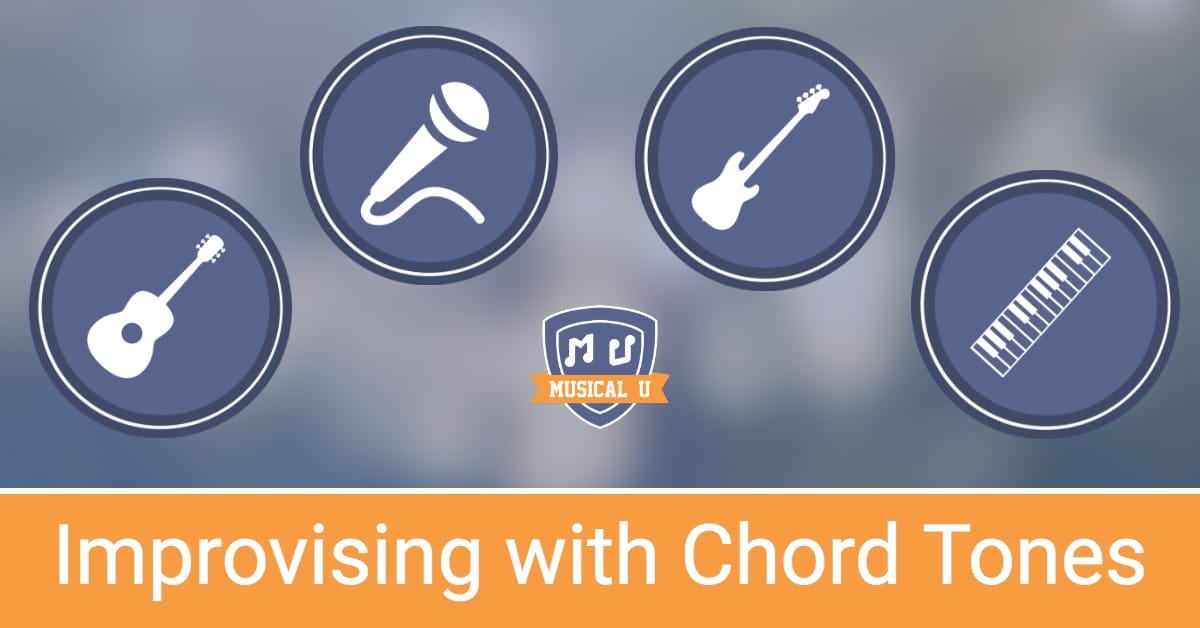 For those more concerned with melody than rhythm, the improvising with chord tones resource pack is the perfect way to take your improvisation beyond the constraints of scales. With instrument-specific tips that incorporate solfege, arpeggiation, and chord knowledge you likely already have, our resident pros will introduce you to a whole new way of soloing!
For those more concerned with melody than rhythm, the improvising with chord tones resource pack is the perfect way to take your improvisation beyond the constraints of scales. With instrument-specific tips that incorporate solfege, arpeggiation, and chord knowledge you likely already have, our resident pros will introduce you to a whole new way of soloing!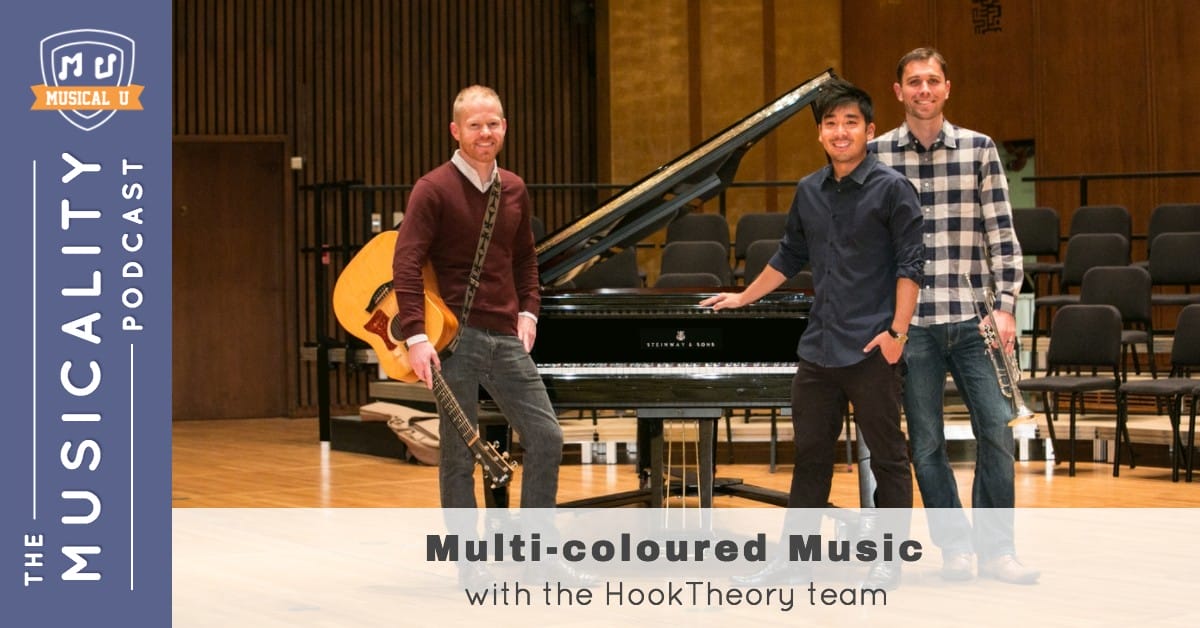 If you’re already familiar with Hook Theory, this will serve as a great behind-the-scenes peek. If you haven’t experienced this tool for yourself, what better way to get acquainted?
If you’re already familiar with Hook Theory, this will serve as a great behind-the-scenes peek. If you haven’t experienced this tool for yourself, what better way to get acquainted?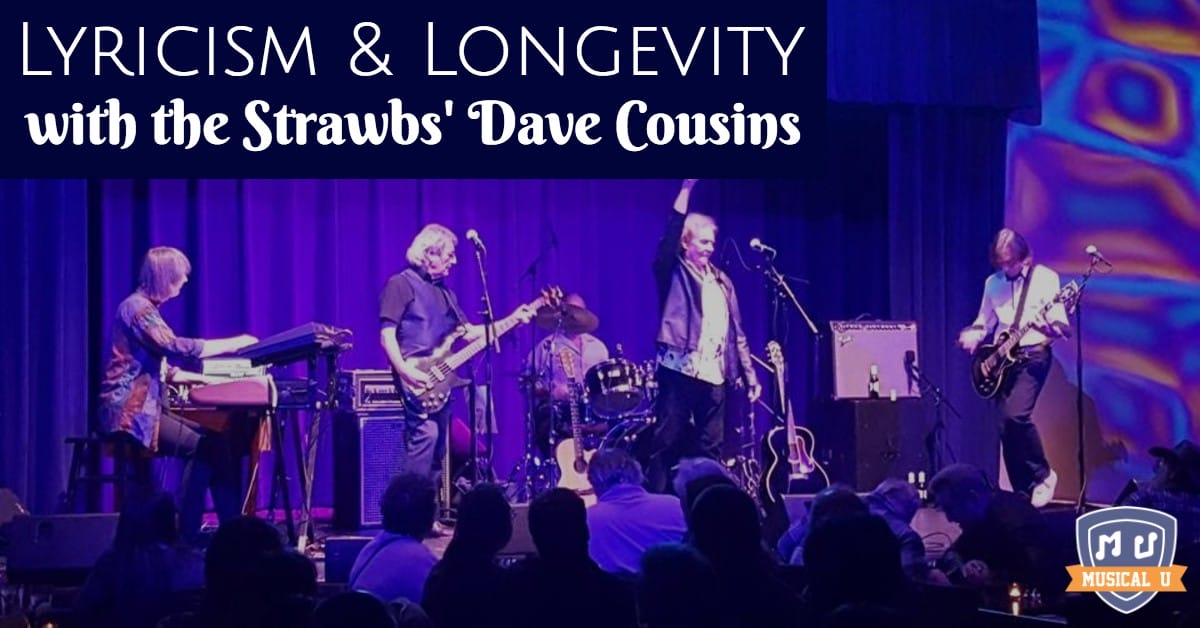 Musical U’s own Stewart Hilton sat down with Dave to discuss the Strawbs’ incredible longevity, how music has changed over the years in his eyes, and of course, Dave’s inimitable approach to writing music and lyrics. Head over to Lyricism and Longevity, with the Strawbs’ Dave Cousins to get a true music veteran’s take on musicality.
Musical U’s own Stewart Hilton sat down with Dave to discuss the Strawbs’ incredible longevity, how music has changed over the years in his eyes, and of course, Dave’s inimitable approach to writing music and lyrics. Head over to Lyricism and Longevity, with the Strawbs’ Dave Cousins to get a true music veteran’s take on musicality.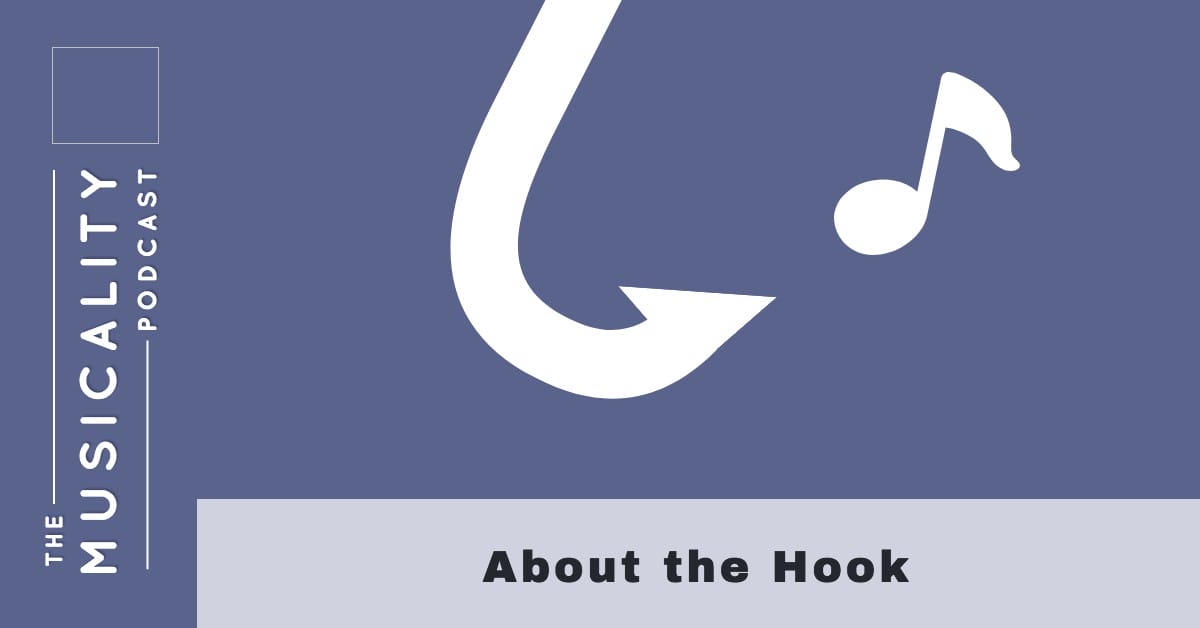 In the Musicality Podcast’s episode About the Hook, we look at what makes a good hook, how it differs from the chorus, and the variety of ways in which famous musicians have used “the hook” to turn their songs into absolute earworms.
In the Musicality Podcast’s episode About the Hook, we look at what makes a good hook, how it differs from the chorus, and the variety of ways in which famous musicians have used “the hook” to turn their songs into absolute earworms.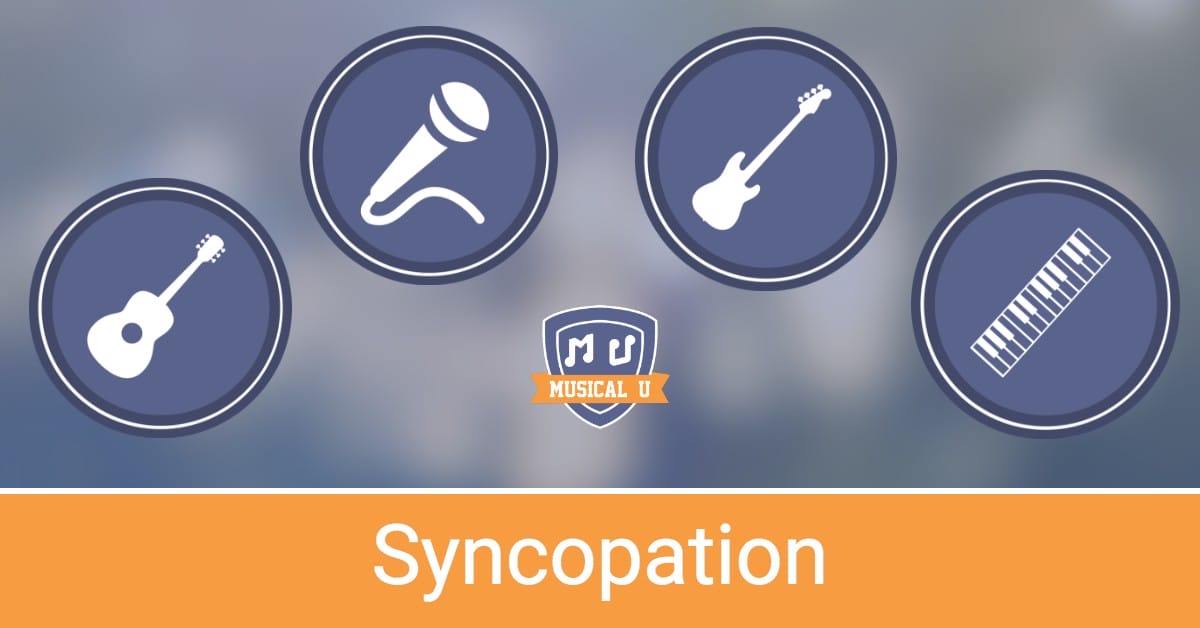
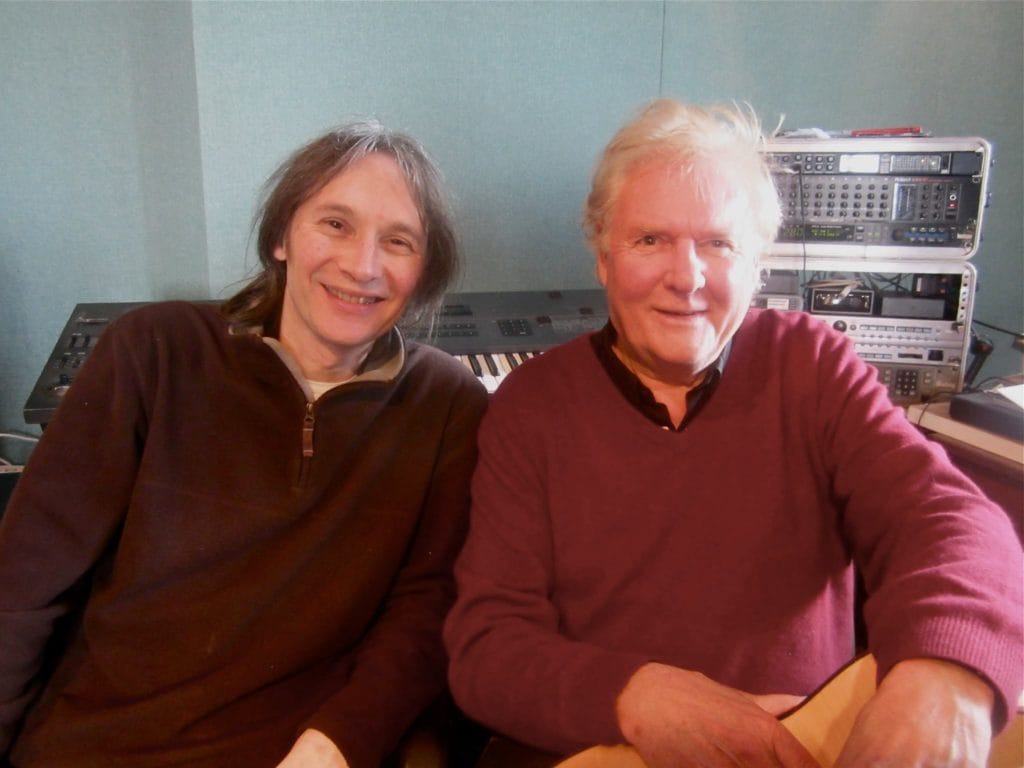
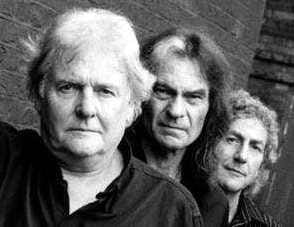 We just like playing the songs. If we all didn’t like playing the songs, we wouldn’t do it.
We just like playing the songs. If we all didn’t like playing the songs, we wouldn’t do it.